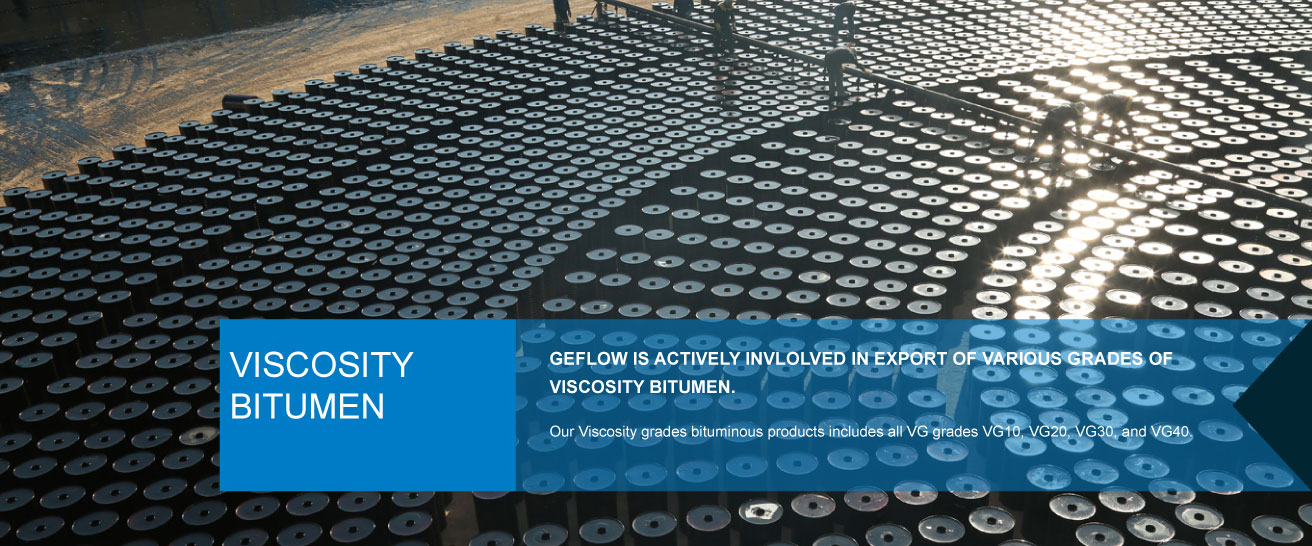
Viscosity Grade Bitumen
Viscosity Grade bitumen has been created to make bitumen’s behavior more predictable at different temperatures, especially the higher ones.
Viscosity grade bitumen is one of the grades of bitumen that has a lot of applications throughout the world. Handling this type of bitumen is easier than penetration grade bitumen in terms of both mixing and compaction, and also its resistance to rutting is much more predictable. Check out this article for more information about the advantages of viscosity grade bitumen.
The manufacturing and grading process of this grade of bitumen is different from other bitumen types. The oxidation of the vacuum bottom generates all bitumen VG grades and the higher the quality of the raw materials, the better the performance of the VG bitumen at the time of application.
Furthermore, the testing and classifying process of viscosity grade bitumen is also different from other bitumen types. After manufacturing, we use a viscometer to classify the VGs based on their viscosity level at 3 different temperatures. More detailed information on viscosity testing can be found here.
Bituminous products are classified into four VG grades using this testing system: VG10, VG20, VG30, and VG40. In the viscosity grading system, the higher the number, the harder the bitumen. Our complete list of applications, grades, and specifications for VG bitumen can be found below.
Each Viscosity Bitumen Grade Standard Application
When it comes to road building, paving sidewalks, spraying, and surface treatment, viscosity grade bitumen is quite popular. Viscosity grade bitumen, the most commonly used bitumen in hot asphalt construction, exhibits thermoplastic qualities that keep this substance hard and stiff in cold weather but flexible in hot weather. At a given temperature, this feature makes the combination of viscosity bitumen with certain other materials more resilient for road building.
It is vital to select the proper grade of viscosity grade bitumen before applying it. Traffic patterns and climate are two major considerations in determining which grade is appropriate. Bitumen with a viscosity value of 10 or 20 is ideal for repairing and paving. Alternatively, VG30 and VG40 are preferred for road-building in areas in which considerable traffic is predicted.
The following sections provide a detailed description of each viscosity grade bitumen application, as well as its features and standards.
VG10 bitumen
The viscosity bitumen VG10 is the softest of the viscosity bitumen grades.
- VG10bitumen is commonly utilized in spraying and surface coating applications.
- Instead of the conventional 80/100 penetration grade, VG10 bitumen is often appropriate for paving roads in extremely cold and cold climates. The ideal air temperature for VG10 bitumen is between -100 and 250 degrees Celsius. Using VG10 will not provide optimal resistance to permanent deformation due to high temperatures in hot climatic conditions.
- Bitumen emulsions and modified bitumen products are also made with this type of bitumen.
- VG10 performs better in cold temperatures as a viscosity grade bitumen. The temperature range of this grade of viscosity bitumen can be seen in the specification table.
The Advantages of Using Viscosity Grade 10 Bitumen
- It is ideal for temperatures less than 30°C.
- It has an absolute viscosity of 800.
- It has a higher penetration value than VG30 and VG40.
VG30 bitumen
- VG30bitumen is the most commonly used form of bitumen in the road, insulation, and building construction sectors, as well as in the manufacturing of cutback bitumen.
- This type of bitumen is generally used to create extra-heavy bitumen pavements that must withstand high traffic loads.
- Manufacturers employ VG30 in high-temperature settings because of its strong thermal susceptibility.
- VG30 bitumen is also appropriate for usage in hot and wet climates and can be used instead of bitumen penetration grades. The higher the viscosity of the bitumen, the less likely it is to be impacted by water.
The Advantages of Using Viscosity Grade 30 Bitumen
- It is best suited for temperatures above 300°C.
- Bitumen with higher viscosity is preferable for clayed soil.
- In wet conditions, VG30 shows a better performance for road construction.
VG40 bitumen
- VG40bitumen is often used in places where heavy traffic loads create high pressure. These areas include intersections, toll booths, and truck parking lots.
- Because of its high viscosity, this type of bitumen is better suited to reducing shoving and other issues linked to heavy traffic loads and hot climates.
The Advantages of Using Viscosity Grade 40 Bitumen
- It can withstand temperatures of up to 40°C.
- It has a viscosity of 3200.
- When a high volume of traffic is anticipated, this is the type of bitumen to use.
Standard Viscosity Grade Bitumen (AC)
Before going through the HMA manufacturing process, the properties of the asphalt binder are specified using AC grading. The viscosity of standard bitumen is measured at 60 degrees Celsius by an asphalt binder.
RTFOT Viscosity Grade Bitumen (AR)
The viscosity of aged residue from the rolling thin film oven test is used in the AR viscosity test. The AR grading system has the potential to simulate the properties of the asphalt binder once it has gone through a typical HMA manufacturing process. As a result, it would be a more accurate representation of how the asphalt binder performs in HMA pavements.
Viscosity grades’ thermoplastic properties cause them to soften at high temperatures and harden at low temperatures. When determining performance parameters such as adhesion, rheology, durability, and application temperatures of bitumen, this distinctive temperature/viscosity relationship is critical.
